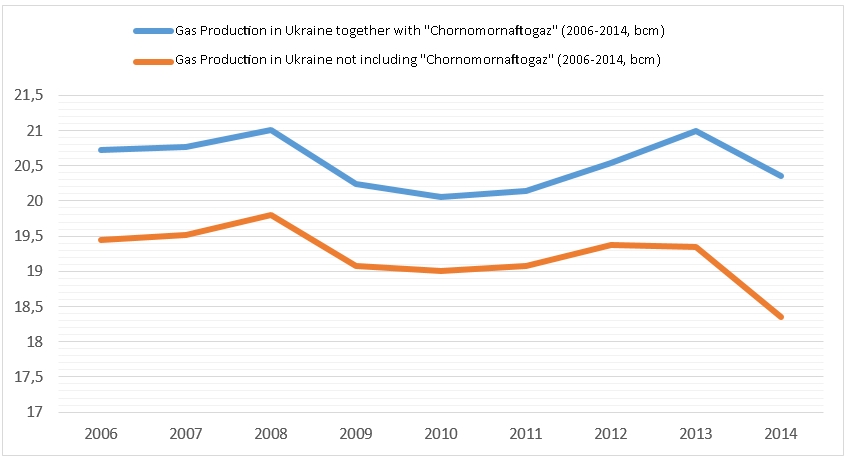Will Ukraine be Gas Self-Sufficient?
In
Login if you are already registered
(no votes) |
(0 votes) |
RIAC Expert
From time to time, Ukrainian energy companies management voice an idea that should certain regulatory conditions be met, Ukraine will be able to provide itself with gas in the upcoming 5-10 years. Oleg Prokhorenko, Chief Executive Officer of Ukrgasvydobuvannya, one of the leading gas companies, states that this level can be achieved even within 5 years if the company manages to fulfil the 20/20 programme, which implies the rise in gas production up to 20
.jpg)
REUTERS/Gleb Garanich
East-Poltava gas condensate field
Ukraine being self-sufficient with gas is an achievable aim. Though it is not due to the gas production growth, or discovering fabulous resources in the grounds of Ukraine, or massive improvement of the Ukrainian economy. It can be real, primarily because of the gas consumption steep fall in the recent 10 years (see Diagram 1). In 2006-2015 the reduction reached 54%. The Ukrainian Minister of Energy’s urge to replace gas with coal «where possible» played a pivotal role. The current coal production in Ukraine is not enough to cover the amount of gas being used in heat power industry. The ecological factor is another thing to keep in mind, as coal Central Heating and Power Plants are proved to be one of the most environmentally-unfriendly kinds of heat power. Taking Ukraine’s distressful economic situation into account, ecological considerations are not of any priority in choosing the suitable energy source.
Diagram 1. Ukraine’s GDP and Gas Consumption in Ukraine in 2006-2015.

Source: World Bank Group, Naftogaz Ukraine.
Ukraine has a sufficient gas storage (about 1 trillion cubic metres) to increase gas production by 5-10
The latter seems attractive with the presence of A. Kvashnevsky, former Polish President and the son of the current U.S. Vice-President J. Biden,
Against the background of «shale gas revolution» in the U.S., the Ukrainian government of V. Yanukovich was aspiring to become a part of the new energy wave. Two projects being symbolic of this willingness - Olesskoye shale gas deposit in the Western Ukraine and Yuzovskoye in the Eastern part of the country. Leading Western companies Chevron and Royal Dutch Shell both signed contracts on production sharing on both deposits accordingly. And even after the military activities started the Ukrainian elite still believed in and hoped for the existence of huge shale gas deposits, some of them seeing the real reason for the allegedly Russia’s interference, as the prospects of Ukraine exporting gas could put Gazprom in an extremely unpleasant position.
Olesskoye deposit is located at the border between Lviv and Ivano-Frankivsky regions, occupying the area of 5,000 sq.km. The geological structure of the deposit is the extension of Baltic and Lyublinsky gas condensate fields located in Poland. And the U.S. Energy Information Administration estimated the shale gas deposits in Poland being 5.6 trillion cubic metres, almost all companies have currently stopped geologic exploration activities at the shale gas deposit areas due to the lack of merchantable gas amount. In December 2014, Chevron refused to further explore Olesskoye deposit for similar reasons: low quality of oil-and-gas source rock, and in the long term, fast field depletion.
The Yuzovskoye deposit being explored by Royal Dutch was, from the Kiev’s point of view, an even more perspective project - it was opened in 2010 a short distance from Donbass coal deposits in Kharkiv and Donetsk regions, and it seemed like a signal for the Ukrainian government to form up
Together with Yuzovskoye deposit, Shell
Diagram 2. Gas Production in Ukraine in 2006-2014.

Source: Naftogaz Ukraine, IHS.
Crimea will never become a new Yamal peninsular or Western Siberia - its resources being estimated by the Minister of Natural Resources and Environment of the Russian Federation S. Donskoy as 47 mln tonnes of oil and 163.5
(no votes) |
(0 votes) |




